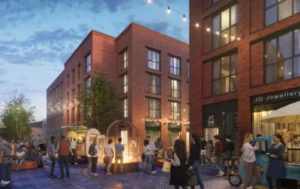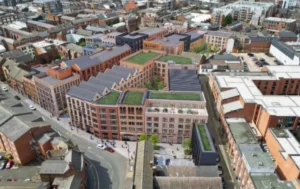Birmingham’s Jewellery Quarter, a district steeped in history and rich industrial heritage, is facing a significant transformation. Plans to build more than 400 new flats in the heart of the Quarter have recently received backing from Birmingham’s planning committee. However, the proposal has ignited a heated debate over the demolition of two notable industrial buildings, with some local groups expressing concerns about the impact on the area’s heritage.
The Development Proposal
At the centre of this controversy is the proposed construction of 422 apartments across four blocks on Northwood Street, just a stone’s throw from Newhall Street and St Paul’s Square. The new development is designed to include not just residential spaces but also commercial areas, with courtyards aimed at creating a vibrant community space for residents and businesses alike.
The development is part of a larger regeneration plan for the Jewellery Quarter, which has witnessed considerable change over the years. The new flats are set to provide much-needed housing for Birmingham, addressing the growing demand for city centre living. The one, two, and three-bedroom apartments will cater to various demographics, offering both private residences and affordable options. With the city experiencing a housing shortage, the proposal seems like a step in the right direction to meet local needs.
However, not everyone is thrilled by the plans. The Jewellery Quarter Development Trust, a local conservation group, has voiced its objections, arguing that demolishing the two existing buildings is both “unacceptable and unnecessary.” These buildings, which date back to the early 20th century, are seen as key to the area’s industrial history and its character.
A Battle Between Regeneration and Preservation
The heart of the controversy lies in the decision to demolish two industrial buildings, located at 123 and 128 Northwood Street. Originally, the developers had planned to retain these buildings in the scheme. However, a report submitted to the council claims that the original plan is no longer financially viable. It states that keeping these buildings would make the project unfeasible and hinder its development.
This justification has not been well received by those who believe the buildings are essential to the character and history of the Jewellery Quarter. The Jewellery Quarter Development Trust insists that these buildings should be preserved, arguing that they form an integral part of the area’s industrial past. The trust’s objections centre on the idea that the demolition of such structures would erase an important aspect of the district’s heritage.
The council’s report acknowledged the significance of the buildings but added that, given the economic challenges of retaining them, their removal could be justified. It argued that the proposed new-build scheme, with its focus on new housing and commercial spaces, would ultimately benefit the area’s economic vitality.
Despite these arguments, local residents and preservationists have raised their voices in protest, fearing that the loss of these buildings could erode the character of the Jewellery Quarter. Many have pointed out that this district has long been a symbol of Birmingham’s industrial legacy, and once these buildings are gone, they cannot be replaced.

Why the Jewellery Quarter Matters
The Jewellery Quarter holds a special place in Birmingham’s history. For over 200 years, it has been a centre for jewellery production and has played a key role in the city’s industrial growth. The area’s narrow streets, with their distinctive Victorian and Edwardian architecture, serve as a reminder of this rich history. Today, it remains a vibrant hub, home to not only jewellers but also a mix of creative businesses, cafes, restaurants, and residential properties.
The Jewellery Quarter is also a conservation area, designated as such by Birmingham City Council in recognition of its historical significance. The district is home to several Grade II listed buildings, and many of its properties are still used for traditional jewellery making, a craft that has been passed down through generations.
For preservationists, the loss of these two industrial buildings represents more than just the demolition of structures; it is a threat to the area’s identity and unique character. The Jewellery Quarter is not just a place to live or work—it’s a living testament to Birmingham’s industrial past. As such, any changes to its fabric must be carefully considered to ensure that the district’s heritage is not lost in the pursuit of new development.
The Case for Demolition
On the other hand, the developers and some members of the local government argue that the demolition of the two buildings is a necessary step to unlock the potential of this underutilised site. The new flats and commercial spaces are seen as vital to the ongoing regeneration of the Jewellery Quarter. The area has changed dramatically in recent years, with new businesses and residents breathing new life into the district.
In their report, the developers stressed the importance of delivering a viable scheme that would support the area’s economic growth. They also pointed out that the site is strategically located near key transport links, including bus routes, which would make it an attractive option for those seeking to live in a central, well-connected location.
Furthermore, the new development is expected to provide a significant amount of commercial space, which could be used to support creative industries and small businesses in the area. With the Jewellery Quarter evolving into a hub for the creative sector, this kind of space could play a pivotal role in the area’s economic future.
A Guaranteed Rent Solution for the New Flats
One innovative aspect of the new flats development plan is the introduction of a guaranteed rent solution, which ensures a stable income stream for investors and developers. This solution provides security for property owners, offering a fixed rental income over a predetermined period, regardless of whether the flats are occupied or not.
This approach reduces the risks commonly associated with property investments, particularly in areas where market demand may fluctuate. By providing a consistent cash flow, it helps property owners feel more secure about their investment. Additionally, this can attract high-quality tenants seeking long-term stability.
For developers, the guaranteed rent option makes the flats more marketable. It’s an attractive solution for those concerned about the possibility of vacancies or slow uptake in new developments. It bridges the gap between building the flats and having them fully occupied, ensuring financial viability during the early years.
The guaranteed rent solution benefits not just investors but also contributes positively to the broader Birmingham housing market. It encourages private sector investment in regeneration projects, especially in high-demand areas like the Jewellery Quarter, where space is limited but demand is strong.

Balancing Heritage and Progress
One of the key challenges facing Birmingham is finding a balance between heritage conservation and the need for modern development. The city’s growth has been rapid in recent years, with a surge in demand for housing and commercial space. This growth has led to a number of redevelopment schemes, some of which have met with opposition due to concerns over the impact on historic buildings.
While it is important to protect Birmingham’s heritage, it is equally essential to provide space for the city’s future. As cities like Birmingham continue to grow, the demand for housing and commercial property is only going to increase. However, this cannot come at the expense of erasing the very character that makes these areas unique.
The challenge lies in finding solutions that allow for growth while respecting the city’s history. Some experts believe that adaptive reuse of buildings—repurposing older structures for new uses—could be a viable alternative to demolition. This approach has been successfully implemented in other cities and could provide a way to preserve the architectural heritage of the Jewellery Quarter while still meeting the demands of modern development.
Looking Ahead
The fate of 123 and 128 Northwood Street will be decided in the coming weeks, as Birmingham’s planning committee considers the proposals. The decision will undoubtedly have far-reaching implications for the future of the Jewellery Quarter. While there is no doubt that the area is in need of regeneration, the challenge lies in ensuring that this does not come at the cost of its heritage.
As Birmingham continues to evolve, it will be crucial to find a way to marry the old with the new. Preserving the character of the Jewellery Quarter while enabling new developments is a delicate balancing act, one that will require careful consideration and input from all stakeholders. Only time will tell whether the city can strike that balance.
For now, the residents of Birmingham’s Jewellery Quarter, along with heritage advocates, will be watching closely as the planning committee prepares to make its decision. The outcome will shape not only the future of this historic district but also the ongoing conversation about how to navigate the challenges of urban growth in a city with such a rich history.

